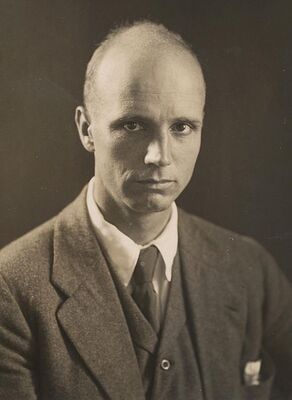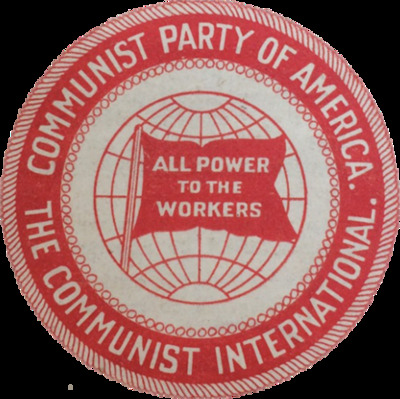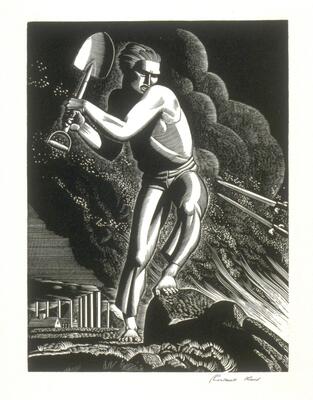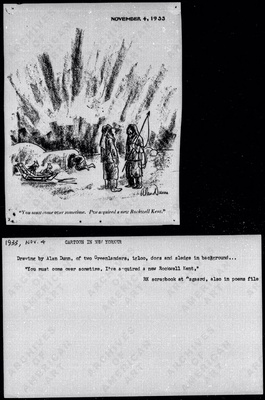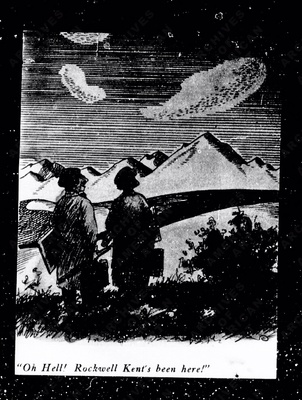The Influences and Opinions Behind Rockwell Kent's Workers of the World, Unite!
By Lowell Kurtz, Bailey Fraker, Sophie Green, and Nala White
The Personal Life of Rockwell Kent
Rockwell Kent (1882-1971) was an American artist from New York. Kent was an artist who indulged in many different forms of art; Kent started out as an architect, studying architecture at Columbia, but later switched to studying art. Kent’s art included sculpture and model making, painting, ceramics, writing, and woodblock prints, which were all products of Kent’s art style. Kent’s personal art style was derived from a few places, namely his political beliefs, and his travels; Kent had political beliefs skewed to the left, and he enjoyed the outdoors, two things which became prevalent themes in his artwork. In Kent’s travels, he enjoyed sailing, and cold environments where he spent a lot of time writing and painting, which aided him in producing many books (whether it be illustrating for others, or writing and illustrating himself).
Kent's Political Life and Opinions
Politics Introduction
Rockwell Kent was incredibly involved in politics and was very outspoken about his opinions. In the United States, he was involved with the International Workers Order and the American Communist Party. He contributed drawings and prints to the socialist political magazine ‘The Masses’ as well as sharing his ideas freely. He believed in workers rights and contributed many prints such as ‘Workers of the World, Unite!’ to express his ideas. He was suspected to be a communist spy by the United States government multiple times. He had to present himself to the House Un-American Activities Committee in 1953. There, he denied being a communist but did not deny his association with communists. After World War 2, he was questioned again for his political standing to the point where the Supreme Court ruled that the State Department had to give him back his passport after it was taken from him. Even though he was successful in maintaining his right to travel, he was shunned from society. He was no longer selling his works and was not invited to show in galleries. This led him to donate a large collection of his work to the Soviet Union that remains in museums in Russia. He became an honorary member of the Soviet Academy of Fine Arts and received the International Lenin Peace Prize for his enormous contribution. He was awarded 28,000 dollars that he specified would go to charities in Vietnam in 1967- after the Vietnam War, meaning he used his life's work to continue to help people.
Russia Context
The 1900s were a period of great change and revolution in Russia, with many events that would lead to the forever transformation of the country. The February Revolution of 1917 was the result of many socio economic and political factors. People in Russia were going through immense poverty and were starving while Russian soldiers were fighting and rapidly losing in World War 1. Russia’s participation in the war was incredibly underfunded, leading to the deaths of many Russian soldiers in a very small amount of time. People felt Czar Nicholas II was not doing enough to help and they blamed him for the economic and military status of the country. Their tension and disappointment led large crowds of women to protest on International Women’s Day in Petrograd (St. Petersburg) on Russian February 23, 1917. These women were met with violence from police forces as well as armed forces. This eventually led to Czar Nicholas II’s abdication. After that there was a Provisional Government called Duma. The changes were followed by military action in the cities of Russia where soldiers would shoot opponents and violence ran rampant. Later in the year, Vladimir Lenin returned to Russia from exile and served as the Bolsheviks’ leader. His opinions were compressed into the slogan “Peace, Bread, Land” which rejected war and appealed to socialist ideas. Lenin believed in violence instead of peace in regards to the revolution. In October of 1917, the Bolsheviks took over government buildings and many other structures, and had almost completely taken over the country by late 1917. They changed from socialists to communists and the Civil War in Russia and eastern Europe began until 1922.
Kent's Artworks and Themes
When it came to his artworks, Rockwell Kent was known widely as a painter and illustrator, but he also excelled with architecture, carpentry, political activism and writing. From a young age he was influenced by art as he lived with his aunt who was a ceramist. Although he did not follow her particular path, Kent spent several summers at various art camps before attending the New York School of Art as well as Columbia for architecture. The contrast between attending art school as well as studying architecture led Kent to grow more fond of painting as a whole and eventually leave Columbia and his architectural education to pursue learning as a full-time painter at the New York School of Art.
Throughout school, Kent’s body of work expanded not only with content but with deeper meanings behind the artwork. He took classes with already-accomplished painters including Robert Henri and Kenneth Hayes Miller. After gaining influence from them along with building his own individual identity as a painter, he moved to Maine and continued on what (at the time) was his most successful subject in painting - landscapes. Kent focused on the beautiful terrain and natural world surrounding him in Maine, producing some of his well known works including Maine Coast and Winter, Monhegan Island, both of which dealt with his easily-identifiable neutral and cool color palette made up of oil paints. Other common destinations translated through a lot of Rockwell Kent’s work include areas in Alaska and Greenland, both places to where he traveled various times as he became more successful as an independent artist.
Workers of the World, Unite! (1937) Description
A singular working man that is symbolic of an entire class of people is the bright white center of Workers of the World, Unite! against a dark, black abyss made of smoke and sky. He, although dressed and armed poorly, holds the advantage above a duo of blade-wielders in a blazing fire while a factory sits behind him in the distance, unaffected by the fight. The uncharacteristically heroic position that the ordinary man takes along with the symbolism of the presence of only one man and even the uniformity of the lines in the artwork all contribute to the central theme of strength in unity that Kent is trying to inspire in the workers of the world. His use of woodcut printing helped to make this piece more reproducible and, therefore, more accessible to large amounts of people in many different places (Lily).
Public Opinion of the Artwork
Based on the political climate of the 1930’s and Kent’s popularity, it is safe to say that the public opinion on “Workers of the World, Unite!” was generally positive. During the 1930’s many Americans believed communism was the answer to overcoming the Great Depression, since capitalism was seen as the reason for the stock market crash that resulted in the Depression (Markowitz) as well as the looming threat of fascism that would end up starting the second World War . Though Kent frequently denied being a communist (Whitman), he was open in his communist-aligning views, which could have allowed a great deal of people to identify and resonate with this particular piece. This is strongly supported by the fact that Kent borrowed the title of his work from The Communist Manifesto by Karl Marx and Friedrich Engels. The full quote reads “Let the ruling classes tremble at a Communistic revolution. The proletarians have nothing to lose but their chains. They have a world to win” (Marx and Engels). It is every evident that this statement (which has been popularized as “Workers of the World, Unite! You have nothing to lose but your chains!”), along with the inspiring nature of the piece, both work together to appeal to the worldwide working class. However, communist views, along with Kent’s own views, also made sure to include people of color in the call for social and economic change (Markowitz). This is shown with Kent’s additional works – New Deal murals – that depicted various indigenous groups and inserted political statements encouraging the freedom of these people (Gordon). Due to this, it may also be safe to say that people of color, especially those who agreed with communist views, may have enjoyed Kent’s piece.
On the contrary, there were multiple cartoons made by other artists, such as Alan Dunn, who satirized Kent’s trip to Greenland, his interactions with indigenous groups that live there, and his artistic style, which were found in the Smithsonian Archives of American Art, Rockwell Kent Papers section. Due to this, a small number of people may have thought of his work as a joke, which may have been either a harmless attempt at comedy or may have been because of his political views and actions.
Sources and Bibliographies
Engels, Frederick, and Marx, Karl. “Chapter IV. Position of the Communists in Relation to the Various Existing Opposition Parties.” Communist Manifesto (Chapter 4), https://www.marxists.org/archive/marx/works/1848/communist-manifesto/ch04.htm.
Gordon, Sarah. "A Call for Liberty: Rockwell Kent's Puerto Rico Mural." The University of Chicago Press Journals. 2019.
https://www.journals.uchicago.edu/doi/10.1086/706831.
This article from The University of Chicago Press Journals explores two murals that Rockwell Kent painted for the U.S. Post Office Department in Washington, D.C. and how they connected to his political views of universal democracy and the liberation of indigenous people in Puerto Rico and Alaska. It analyzes the details of the murals, shows the preliminary sketches, and presents his travels and affilifations with socialist groups. This work is written as a research article, so it is likely that it is meant for those who do not know much about the subject. For this website, it is particularly useful in bringing outside information to infer about how Kent’s political views and other artworks relate to Workers of the World, Unite! It may also provide insight on who would have enjoyed that piece. This article is particularly strong because it goes into extensive details and also brings other artworks by Kent to make comparisons.
Green, John. "Russian Revolution and Civil War: Crash Course European History #35" Crash Course. 13, Feb. 2020. https://www.youtube.com/watch?v=U6KR4cLLVzQ.
History.com Editors. "Russian Revolution." HISTORY. 20, Apr. 2023. https://www.history.com/topics/european-history/russian-revolution.
Lily, Amy. "Rockwell Kent's Dramatic Black-and-White Prints Show at the Fleming Museum." Seven Days. 2022. https://www.sevendaysvt.com/arts-culture/rockwell-kents-dramatic-black-and-white-prints-show-at-the-fleming-museum-36832461.
Markowitz, Norman. "The Communist Party in the '30s: The Depression and great upsurge." People's World. 14, May 2019.
Samels, Zoë. "Rockwell Kent." National Gallery of Art. 29, Sep. 2016. https://www.nga.gov/collection/artist-info.4494.html.
Unknown. "Rockwell Kent." Artnet. https://www.artnet.com/artists/rockwell-kent/.
Unknown. "Soviet Union timeline" BBC. 31, Oct. 2013. https://www.bbc.com/news/world-europe-17858981.
Unknown. "Rockwell Kent." Smithsonian American Art Museum. https://www.aaa.si.edu/collections/rockwell-kent-papers-9557/series-4/reel-5253-frames-423-435.
Unknown. "Rockwell Kent (1882-1971)." Sullivan Goss An American Gallery. https://www.sullivangoss.com/artists/rockwell-kent-1882-1971.
Unknown. "Rockwell Kent." U.S. General Services Administration. 19, Apr. 2022. https://www.gsa.gov/real-estate/gsa-properties/visiting-public-buildings/william-jefferson-clinton-federal-building/whats-inside/wheres-the-art/rockwell-kent.
Whitman, Alden. "Man of Multiple Skills." The New York Times. 14, Mar. 1971.
Created For
K-12 EducatorK-12 Student
Museum Visitor
UMMA Docent
UMMA Staff
University Faculty
University Student
Rate this Resource
AVG: 0 | Ratings: 0
& Author Notes
All Rights ReservedLast Updated
December 3, 2023 2:37 p.m.Report
Reporting Policy
